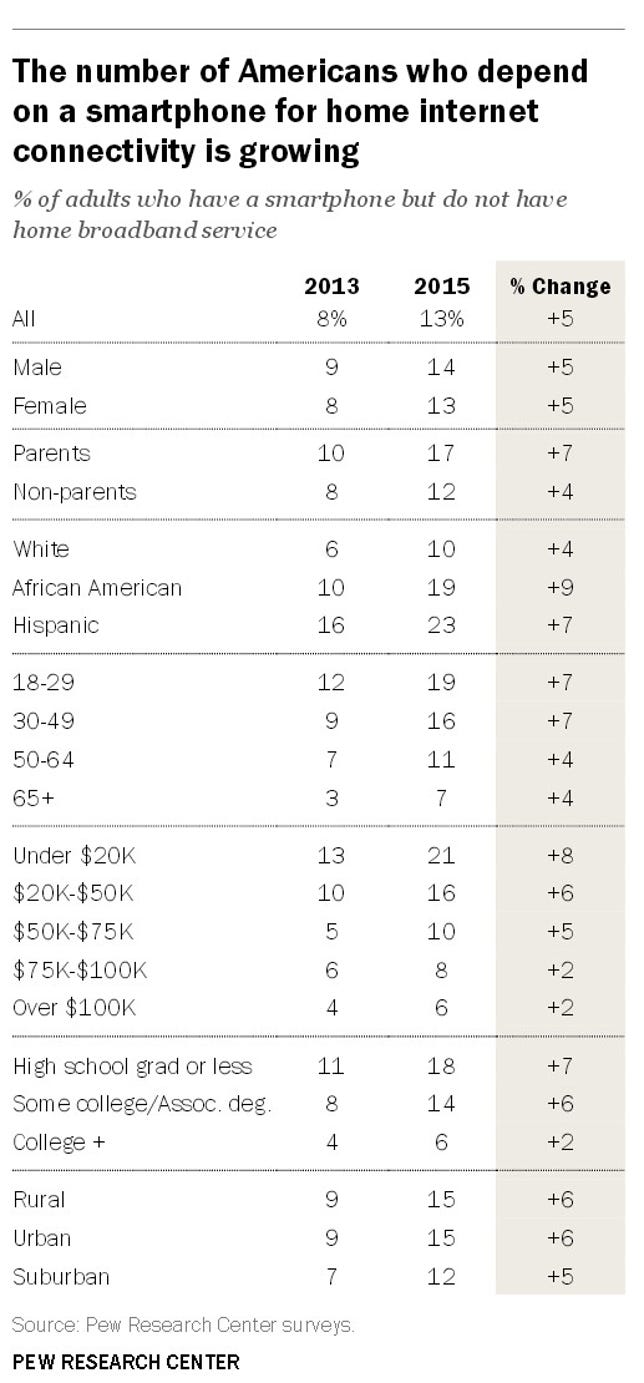Politicians and regulators, take notice: More Americans are relying solely on wireless access at home and away for Internet and video content.
That’s according to data released Monday (PDF) by the Pew Research Center, based on a survey from earlier this year.
Between home broadband and mobile, 80 percent of adults now have high-speed Internet access, a modest increase from 2013. While the percentage of home broadband connections has stayed more or less constant, smartphone adoption has advanced at a feverish pace. Nearly 70 percent of all US adults now have a smartphone, roughly the same as have broadband at home. Over half now have both home and mobile connections.
These are remarkable results, given that broadband Internet has existed only since the mid-1990s and that smartphones became a mass-market phenomenon some 10 years after that. Landline telephone service, in comparison, never reached more than 95 percent penetration even after decades of universal availability.
Just look up from your own smartphone at the dinner table or in front of the TV to see what your companions are up to, how heavily invested we all are in the mobile Internet. If you weren’t just using your iPhone or Galaxy to check work email, you were posting a photo to Instagram, viewing a video that a friend posted to Facebook or tweeting your reaction to a crucial play in an NFL game.
A key takeaway from the Pew survey is that the number of Americans who rely exclusively on a mobile connection for broadband has risen sharply, from 8 percent in 2013 to 13 percent this year. Many are among the millions who previously resisted going online at all, helping to close what remains of the “digital divide,” especially among African-American, Hispanics and lower-income Americans.

 Enlarge Image
Enlarge ImageThe Pew findings offer some sobering news, however, for policymakers at the Federal Communications Commission and the White House, who hope to solve what remains of the lack-of-access problem through low-cost or free Internet service. The FCC has been pushing to reallocate the multibillion-dollar Lifeline fund, created to provide dial tone for low-income consumers, to instead support home or mobile broadband connections. (Lifeline is paid for by fees on your telephone bill.)
Here’s the thing: The latest data suggests that subsidizing the cost of Internet access may do little to convert the 20 percent of Americans who still don’t have a high-speed connection.
Consistent with earlier Pew studies, only a third of nonsubscribers (including those who may once have had service) cited the cost of broadband access as their “most important reason” not to have a connection at home. Meanwhile, 10 percent point to the price of a home computer, and 20 percent rely on their smartphone or other access outside the home.
Most revealing of all, among “hard to reach” consumers — those who have never had a home broadband connection — only a quarter cite price as their biggest barrier. According to the Pew findings, just 25 percent of nonadopters are interested in someday subscribing to broadband service, while 70 percent say they’re not interested, at any price.
The real holdup to broader home adoption, in other words, has little to do with its cost. What then? Earlier Pew studies, including one in 2013, found instead that two-thirds of nonadopters cited relevance or usability as their main reason not to use the Internet at all.
It’s not clear how dominant those obstacles remain. Unfortunately, the 2015 survey did not use the same methodology as earlier Pew studies, which asked non-Internet users to list their reasons in an open-ended question. The new study was narrower, focusing only on adults without a home broadband connection and offering them a specific list of choices for reasons not to subscribe.
John Horrigan, senior researcher for the report released Monday, acknowledged the lack of an apples-to-apples comparison. He did say other data indicates lack of relevance has receded as a reason not to adopt.
Still, the survey acknowledges that consumers who never had a home broadband connection and don’t want one “are less likely to cite the monthly access fee as their most important reason for not having service.” Instead, other demographics suggest why this group remains outside the broadband ecosystem. Almost 40 percent of this group is over 65, for example. And only 8 percent have a college degree. Less than half use the Internet at all.
Increased awareness among the holdouts of the importance of broadband access is certainly a welcome finding. But for many of the millions of Americans who have never had a home broadband connection, the increasing functionality, ease of use and flexibility of mobile devices may hold the key to completing the broadband revolution.
For policymakers, these findings point away from simple subsidies. Instead, their focus needs to shift to freeing up more radio spectrum for faster and higher-capacity wireless networks, and doing so quickly. Federal and state regulators must also redouble efforts to remove bureaucratic obstacles to deployment of new broadband infrastructure, including cell towers, antennas and fiber-optic cables.
And, most important of all, continue to educate consumers on the importance of the Internet in their daily lives.




